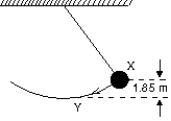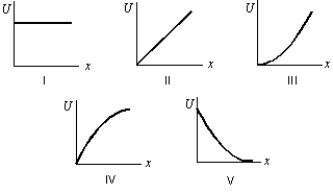A) I
B) II
C) III
D) IV
E) V
Correct Answer

verified
Correct Answer
verified
Multiple Choice
A 0.50-kg block attached to an ideal spring with a spring constant of 80 N/m oscillates on a horizontal frictionless surface. The total mechanical energy is 0.12 J. The greatest speed of the block is:
A) 0.15 m/s
B) 0.24 m/s
C) 0.49 m/s
D) 0.69 m/s
E) 1.46 m/s
Correct Answer

verified
Correct Answer
verified
Multiple Choice
A 700-N man jumps out of a window into a fire net 10 m below. The net stretches 2 m before bringing the man to rest and tossing him back into the air. The maximum potential energy of the net, compared to its unstretched potential energy, is:
A) 300 J
B) 710 J
C) 850 J
D) 7000 J
E) 8400 J
Correct Answer

verified
Correct Answer
verified
Multiple Choice
A 2.2-kg block starts from rest on a rough inclined plane that makes an angle of 25 with the horizontal. The coefficient of kinetic friction is 0.25. As the block goes 2.0 m down the plane, the mechanical energy of the Earth-block system changes by:
A) 0 J
B) -9.8 J
C) 9.8 J
D) -18 J
E) 18 J
Correct Answer

verified
Correct Answer
verified
Multiple Choice
A body at rest in a system is capable of doing work if:
A) the potential energy of the system is positive
B) the potential energy of the system is is negative
C) it is free to move in such a way as to decrease its kinetic energy
D) it is free to move in such a way as to decrease the potential energy of the system
E) it is free to move in such a way as to increase the potential energy of the system
Correct Answer

verified
Correct Answer
verified
Multiple Choice
A simple pendulum consists of a 2.0 kg mass attached to a string. It is released from rest at X as shown. Its speed at the lowest point Y is: 
A) 1.9 m/s
B) 3.7 m/s
C) 4.4 m/s
D) 6.0 m/s
E) 36 m/s
Correct Answer

verified
Correct Answer
verified
Multiple Choice
Only if a force on a particle is conservative:
A) does it do no work when the particle moves exactly once around any closed path
B) does the work it does equal the change in the kinetic energy of the particle
C) does it obey Newton's second law
D) does it obey Newton's third law
E) it is not a frictional force
Correct Answer

verified
Correct Answer
verified
Multiple Choice
A particle moves along the x axis under the influence of a stationary object. The net force on the particle, which is conservative, is given by F = (8N/m3) x3. If the potential energy is taken to be zero for x = 0 then the potential energy is given by:
A) (2 J/m4) x4
B) (-2 J/m4) x4
C) (24 J/m2) x2
D) (-24 J/m2) x2
E) 5 J - (2 J/m4) x4
Correct Answer

verified
Correct Answer
verified
Multiple Choice
A good example of kinetic energy is provided by:
A) a wound-up clock spring
B) the raised weights of a grandfather's clock
C) a tornado
D) a gallon of gasoline
E) an automobile storage battery
Correct Answer

verified
Correct Answer
verified
Multiple Choice
A rectangular block is moving along a frictionless path when it encounters the circular loop as shown. The block passes points 1,2,3,4,1 before returning to the horizontal track. At point 3: 
A) its mechanical energy is a minimum
B) the forces on it are balanced
C) it is not accelerating
D) its speed is a minimum
E) it experiences a net upward force
Correct Answer

verified
Correct Answer
verified
Multiple Choice
A block slides across a rough horizontal table top. The work done by friction changes:
A) only the kinetic energy
B) only the potential energy
C) only the thermal energy
D) only the kinetic and potential energies
E) only the kinetic and thermal energies
Correct Answer

verified
Correct Answer
verified
Multiple Choice
A 0.50-kg block attached to an ideal spring with a spring constant of 80 N/m oscillates on a horizontal frictionless surface. When the spring is 4.0 cm longer than its equilibrium length, the speed of the block is 0.50 m/s. The greatest speed of the block is:
A) 0.32 m/s
B) 0.55 m/s
C) 0.71 m/s
D) 0.87 m/s
E) 0.93 m/s
Correct Answer

verified
Correct Answer
verified
Multiple Choice
A stationary mass m = 1.3 kg is hanging from a spring of spring constant k = 1200 N/m. You raise the mass a distance of 10 cm above its equilibrium position in a time of 1.4 s. What was the average power expended?
A) 0.93 W
B) 4.3 W
C) 5.2 W
D) 8.6 W
E) 10.2 W
Correct Answer

verified
Correct Answer
verified
Multiple Choice
The sum of the kinetic and potential energies of a system of objects is conserved:
A) only when no external force acts on the objects
B) only when the objects move along closed paths
C) only when the work done by the resultant external force is zero
D) always
E) none of the above
Correct Answer

verified
Correct Answer
verified
Multiple Choice
The potential energy of a 0.20-kg particle moving along the x axis is given by U(x) =(8.0 J/m2) x2 + (2.0 J/m4) x4. When the particle is at x = 1.0 m it is traveling in the positive x direction with a speed of 5.0 m/s. It next stops momentarily to turn around at x =
A) 0 m
B) -1.1 m
C) 1.1 m
D) -2.3 m
E) 2.3 m
Correct Answer

verified
Correct Answer
verified
Multiple Choice
A 0.50-kg block attached to an ideal spring with a spring constant of 80 N/m oscillates on a horizontal frictionless surface. The total mechanical energy is 0.12 J. The greatest extension of the spring from its equilibrium length is:
A) 1.5 * 10-3 m
B) 3.0 * 10-3 m
C) 0.039 m
D) 0.055 m
E) 18 m
Correct Answer

verified
Correct Answer
verified
Multiple Choice
A block of mass m is initially moving to the right on a horizontal frictionless surface at a speed v. It then compresses a spring of spring constant k. At the instant when the kinetic energy of the block is equal to the potential energy of the spring, the spring is compressed a distance of:
A) ![]()
B) (1/2) mv2
C) (1/4) mv2
D) mv2/4k
E) (1/4)
Correct Answer

verified
Correct Answer
verified
Multiple Choice
A small object of mass m, on the end of a light cord, is held horizontally at a distance r from a fixed support as shown. The object is then released. What is the tension in the cord when the object is at the lowest point of its swing? 
A) mg/2
B) mg
C) 2 mg
D) 3 mg
E) mgr
Correct Answer

verified
Correct Answer
verified
Multiple Choice
The potential energy of a 0.20-kg particle moving along the x axis is given by U(x) = (8.0 J/m2) x2 − (2.0 J/m4) x4. When the particle is at x = 1.0 m the magnitude of its acceleration is:
A) 0 m/s2
B) -8 m/s2
C) 8 m/s2
D) -40 m/s2
E) 40 m/s2
Correct Answer

verified
Correct Answer
verified
Multiple Choice
Which of the five graphs correctly shows the potential energy of a spring as a function of its elongation x? 
A) I
B) II
C) III
D) IV
E) V
Correct Answer

verified
Correct Answer
verified
Showing 41 - 60 of 63
Related Exams